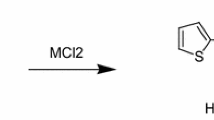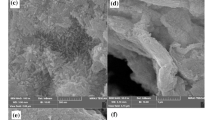Abstract
An efficient, green, novel and rapid vortex-assisted dispersive solid-phase extraction (VADSPE) technique was used for the preconcentration and determination of trace levels of Cu2+ followed by flame atomic absorption spectrometry. Graphene oxide (GO) was synthesized from graphite and then modified by pectic acid (poly-d-galacturonic acid, PA) to synthesize the pectic acid–graphene oxide (PA-GO) nanocomposite. The Fourier transform infrared spectrophotometry, field emission scanning electron microcopy, energy-dispersive X-ray spectroscopy and X-ray diffraction analysis were used to characterize the synthesized GO-PA nanocomposite. By using VADSPE technique, PA-GO was used as an adsorbent for preconcentration of Cu2+. The main parameters affecting the extraction recovery, including pH of the sample solution, amounts of adsorbent, extraction time, type and concentration of desorbent solvent and desorption time were completely investigated and optimized. Under the optimum conditions, the results show that the proposed method has the linearity range of 10–300 µg L−1 with a correlation coefficient of 0.9950. The limit of detection based on six replicate analyses of the blank sample was 2.22 µg L−1, and the relative standard deviation was 2.7% for the five replicate analysis of 50 µg L−1 Cu2+. The validity of the proposed method was checked by the analysis of two certified reference materials including CRM-TMDW and GBW07605 tea samples, and then, the proposed method was successfully applied for the determination of trace levels of Cu2+ in different water and food samples.








Similar content being viewed by others
References
Bost M, Houdart S, Oberli M, Kalonji E, Huneau JF, Margaritis I (2016) Dietary copper and human health: current evidence and unresolved issues. J Trace Elem Med Biol 35:107–115
Uriu-Adams JY, Keen CL (2005) Copper, oxidative stress, and human health. Mol Asp Med 26:268–298
Jihad Majeed H, Eftekhari M, Gheibi M, Chamsaz M (2019) Synthesis and application of cerium oxide nanoparticles for preconcentration of trace levels of copper in water and foods followed by flame atomic absorption spectrometry. J Food Meas Charact 13:339–346
Zou J, Ma X, Dang Y, Chen Y (2014) Trace determination of cadmium(II) and copper(II) in environmental water samples by solid-phase extraction using a novel ionic liquid-modified composite sorbent combined with flame atomic absorption spectrometry. J Anal Atom Spectrom 29:1692–1697
Frag EY, Abdel Hameed RM (2019) Preparation, characterization and electrochemical application of CuNiO nanoparticles supported on graphite for potentiometric determination of copper ions in spiked water samples. Microchim J 144:110–116
Zamani Mohammadabadi S, Zanganeh AR (2018) Electrochemically generated recognition sites in self-doped polyaniline modified electrodes for voltammetric and potentiometric determination of copper(II) Ion. Electroanalysis 30:415–425
Zhang Y, Zhong C, Zhang Q, Chen B, He M, Hu B (2015) Graphene oxide–TiO2 composite as a novel adsorbent for the preconcentration of heavy metals and rare earth elements in environmental samples followed by on-line inductively coupled plasma optical emission spectrometry detection. RSC Adv 5:5996–6005
Otero-Romaní J, Moreda-Piñeiro A, Bermejo-Barrera A, Bermejo-Barrera P (2005) Evaluation of commercial C18 cartridges for trace elements solid phase extraction from seawater followed by inductively coupled plasma-optical emission spectrometry determination. Anal Chim Acta 536:213–218
Wen X, Yang Q, Yan Z, Deng Q (2011) Determination of cadmium and copper in water and food samples by dispersive liquid–liquid microextraction combined with UV–Vis spectrophotometry. Microchim J 97:249–254
Horstkotte B, Alexovič M, Maya F, Duarte CM, Andruch V, Cerdá V (2012) Automatic determination of copper by in-syringe dispersive liquid–liquid microextraction of its bathocuproine-complex using long path-length spectrophotometric detection. Talanta 99:349–356
Chamsaz M, Eftekhari M, Eftekhari A, Yekkebashi A (2013) 2-Nitroso-1-naphthol as a selective reagent for preconcentration of cobalt by vortex assisted combined with solidification of organic droplet and its determination by flame atomic absorption spectrometry. Environ Monit Assess 185:9067–9075
Khodarahmi M, Eftekhari M, Gheibi M, Chamsaz M (2018) Preconcentration of trace levels of cadmium (II) ion using Descurainia sophia seeds as a green adsorbent for solid phase extraction followed by its determination by flame atomic absorption spectrometry. J Food Meas Charact 12:1485–1492
Mohammadnezhad G, Moshiri P, Dinari M, Steiniger F (2019) In situ synthesis of nanocomposite materials based on modified-mesoporous silica MCM-41 and methyl methacrylate for copper (II) adsorption from aqueous solution. J Iran Chem Soc 16:1491–1500
Kobylinskaya NG, Khainakova EA, Diaz-Garcia ME, Zaitsev VN (2017) Nanocomposites based on magnetite modified by chelate groups for a solid-phase concentration of heavy-metal ions from aqueous solutions. Prot Met Phys Chem Surf 53:675–684
Khayatian G, Moradi M, Hassanpoor S (2018) MnO2/3MgO Nanocomposite for preconcentration and determination of trace copper and lead in food and water by flame atomic absorption spectrometry. J Anal Chem 73:470–478
Soylak M, Doğan M (1996) Column preconcentration of trace amounts of copper on activated carbon from natural water samples. Anal Lett 29:635–643
Tuzen M, Soylak M, Citak D, Ferreira HS, Korn MGA, Bezerra MA (2009) A preconcentration system for determination of copper and nickel in water and food samples employing flame atomic absorption spectrometry. J Hazard Mater 162:1041–1045
Soylak M, Kiranartligiller E (2017) A simple vortex-assisted dispersive liquid–liquid microextraction system for copper(II) to preconcentration and separation from natural water and table salt samples. Arab J Sci Eng 42:175–181
Jalbani N, Soylak M (2015) Ligandless ultrasonic-assisted and ionic liquid-based dispersive liquid–liquid microextraction of copper, nickel and lead in different food samples. Food Chem 167:433–437
Karadaş C, Kara D (2017) Dispersive liquid–liquid microextraction based on solidification of floating organic drop for preconcentration and determination of trace amounts of copper by flame atomic absorption spectrometry. Food Chem 220:242–248
Yang S, Fang X, Duan L, Yang S, Lei Z, Wen X (2015) Comparison of ultrasound-assisted cloud point extraction and ultrasound-assisted dispersive liquid liquid microextraction for copper coupled with spectrophotometric determination. Spectrochim Acta A Mol Biomol Spect 148:72–77
Hemmati M, Rajabi M, Asghari A (2018) Magnetic nanoparticle based solid-phase extraction of heavy metal ions: a review on recent advances. Microchim Acta 185:160–191
Eftekhari M, Gheibi M, Akrami M, Iranzad F (2018) Solid-phase extraction of ultra-trace levels of lead using tannic acid-coated graphene oxide as an efficient adsorbent followed by electrothermal atomic absorption spectrometry; response surface methodology-central composite design. New J Chem 42:1159–1168
Ghahramani A, Gheibi M, Eftekhari M (2018) Polyaniline-coated reduced graphene oxide as an efficient adsorbent for the removal of malachite green from water samples. Polym Bull. https://doi.org/10.1007/s00289-018-2651-0
Yuan Y, Zhang G, Li Y, Zhang G, Zhang F, Fan X (2013) Poly(amidoamine) modified graphene oxide as an efficient adsorbent for heavy metal ions. Polym Chem 4:2164–2167
Arshad F, Selvaraj M, Zain J, Banat F, Haija MA (2019) Polyethylenimine modified graphene oxide hydrogel composite as an efficient adsorbent for heavy metal ions. Sep Purif Technol 209:870–880
Bagliotti Meneguin A, Stringhetti Ferreira Cury B, Cesar Evangelista R (2014) Films from resistant starch-pectin dispersions intended for colonic drug delivery. Carbohydr Polym 99:140–149
Minhas MU, Ahmad M, Anwar J, Khan S (2018) Synthesis and characterization of biodegradable hydrogels for oral delivery of 5-fluorouracil targeted to colon: screening with preliminary in vivo studies. Adv Polym Tech 37:221–229
Ayala-Cabrera JF, Trujillo-Rodríguez MJ, Pino V, Hernández-Torres OM, Afonso AM, Sirieix-Plénet J (2016) Ionic liquids versus ionic liquid-based surfactants in dispersive liquid–liquid microextraction for determining copper in water by flame atomic absorption spectrometry. Int J Environ Anal Chem 96:101–118
Mohammadi SZ, Seyedi F (2016) Preconcentration of cadmium and copper ions on magnetic core–shell nanoparticles for determination by flame atomic absorption. Toxicol Environ Chem 98:705–713
Yavuz E, Tokalıoğlu S, Sahan H, Patat S (2016) Nanosized spongelike Mn3O4 as an adsorbent for preconcentration by vortex assisted solid phase extraction of copper and lead in various food and herb samples. Food Chem 194:463–469
Durukan I, Şahin CA, Bektaş S (2011) Determination of copper traces in water samples by flow injection-flame atomic absorption spectrometry using a novel solidified floating organic drop microextraction method. Microchem J 98:215–219
Es’haghi Z, Azmoodeh R (2010) Hollow fiber supported liquid membrane microextraction of Cu2+ followed by flame atomic absorption spectroscopy determination. Arab J Chem 3:21–26
Acknowledgements
The authors wish to thank the University of Neyshabur (Grant No. 1278) for the financial support of this project. Also, we have appreciated the Iran Laboratory, Mashhad, Iran, for the assistance to complete this project.
Author information
Authors and Affiliations
Corresponding author
Additional information
Publisher's Note
Springer Nature remains neutral with regard to jurisdictional claims in published maps and institutional affiliations.
Rights and permissions
About this article
Cite this article
Eftekhari, A., Shakerian, M., Majeed, H.J. et al. Pectic acid–graphene oxide nanocomposite as an adsorbent in vortex-assisted dispersive solid-phase extraction for preconcentration of copper ion followed by flame atomic absorption spectrometry. Polym. Bull. 77, 2821–2836 (2020). https://doi.org/10.1007/s00289-019-02884-y
Received:
Revised:
Accepted:
Published:
Issue Date:
DOI: https://doi.org/10.1007/s00289-019-02884-y




